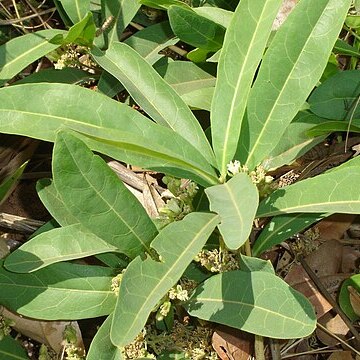Low rhizomatous suffrutex. Stipules narrowly triangular to subulate, (2-)3-6(-7) mm long. Leaves usually sessile, elliptic to obovate, up to 12 times as long as wide, 50-130 x 20-40 mm, nervation prominent. Inflorescence rather loose, distinctly branched. Petals and sepals narrowly oblong. Flowers white.
A small shrub. It grows 30 cm high. It has branched underground stems. It forms colonies. It loses its leaves during the year. The flowers are small and white. They are in clusters. They have a scent. The fruit are yellow and egg shaped. They have one large seed.
Cymes up to 5 cm. long, c. 8-flowered; peduncle sparsely hairy or glabrous, partially adnate to the stem for c. 5 mm. above the axil; pedicels ± 2 mm. long; bracts c. 2 mm. long.
Sepals c. 7 mm. long, narrow, free almost to the base, tomentose at the apex, becoming glabrous towards the base.
Petals c. 7 mm. long, narrowly oblong, 2-fid for 2/3 their length, glabrous.
Stems simple from a creeping woody rhizome, pubescent, striate.
Ovary villous; style c. 6 mm. long, deeply 3-divided.
Fruit 4 × 2·5 cm., obovoid.
Stamens as long as petals.


